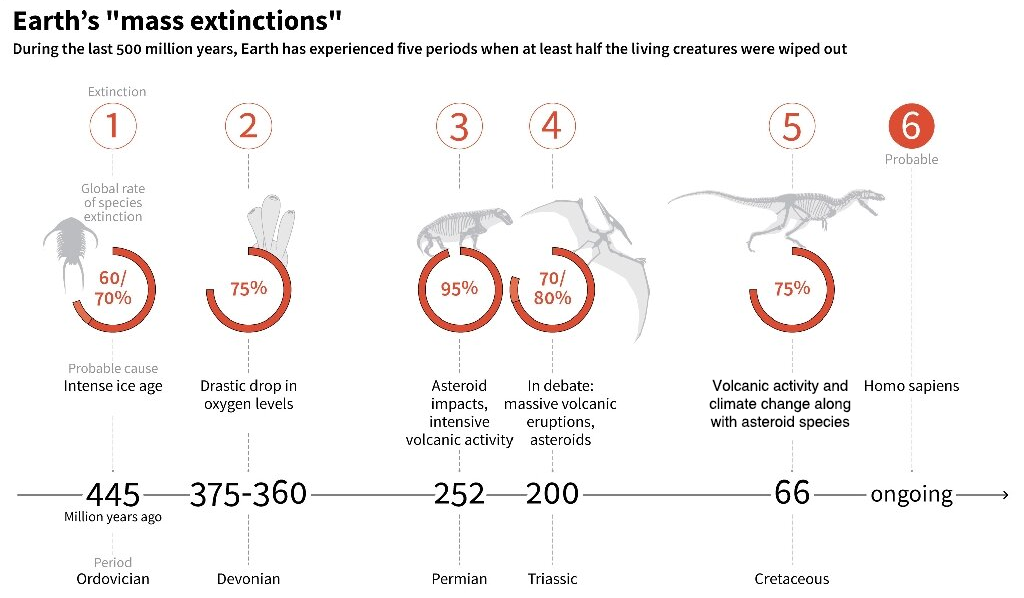Biodiversity & Environment
Mass Extinction
- 08 Nov 2021
- 5 min read
Why in News
Recently, a paper published in the international journal Nature Geoscience has come up with a new reason behind the first mass extinction, also known as the Late Ordovician mass extinction.
- It notes that the cooling climate likely changed the ocean circulation pattern. This caused a disruption in the flow of oxygen-rich water from the shallow seas to deeper oceans, leading to a mass extinction of marine creatures.
Key Points
- Mass Extinction (Meaning):
- A mass extinction event is when species vanish much faster than they are replaced.
- This is usually defined as about 75% of the world's species being lost in a 'short' amount of geological time - less than 2.8 million years.
- Mass Extinctions So Far:
- First Mass Extinction: The Ordovician mass extinction that occurred about 445 million years ago killed about 85% of all species.
- Second Mass Extinction: The Devonian mass extinction (about 375 million years ago) wiped out about 75% of the world’s species.
- Third Mass Extinction: The Permian mass extinction (about 250 million years ago) also known as the Great Dying caused the extinction of over 95% of all species.
- Fourth Mass Extinction: The Triassic mass extinction (about 200 million years ago) eliminated about 80% of Earth’s species, including some dinosaurs.
- Fifth Mass Extinction: This Cretaceous mass extinction (about 65 million years ago) is known for wiping out non-avian dinosaurs.
- About the Latest Findings:
- New Explanations: There have been several theories behind each mass extinction and with advances in new technologies, researchers have been uncovering more intricate details about these events.
- Traditional Thought: For decades, the prevailing school of thought was that volcanism-induced global warming causes the oceans to lose oxygen and thus impact marine habitability, potentially destabilising the entire ecosystem.
- New School of Thought: In recent years, mounting evidence points to several episodes in the Earth’s history when oxygen levels also dropped in cooling climates.
- Ordovician climate and marine biogeochemical cycles during that period showed “seafloor and upper-ocean oxygenation in response to ongoing global cooling.”
- This led to deep-sea anoxia affecting ocean circulation.
- Thus, the paper concludes that climate cooling may have led to changes in nutrient cycling, primary producer communities which ultimately drove the Late Ordovician mass extinction.
- Ordovician climate and marine biogeochemical cycles during that period showed “seafloor and upper-ocean oxygenation in response to ongoing global cooling.”
- Ongoing Sixth Mass Extinction and Impact:
- Sixth Mass Extinction:
- Some researchers have pointed out that we are currently experiencing a sixth mass extinction as the result of human-induced climate change (referred to as the Anthropocene extinction).
- Currently, only an estimated 2% of all of the species that ever lived are alive but the absolute number of species is greater than ever before.
- It is described as the most serious environmental problem since the loss of species will be permanent.
- The loss of species has been occurring since human ancestors developed agriculture over 11,000 years ago. Since then, the human population has increased from about 1 million to 7.7 billion.
- Some researchers have pointed out that we are currently experiencing a sixth mass extinction as the result of human-induced climate change (referred to as the Anthropocene extinction).
- Possible Impact:
- The extinction of the species causes tangible impact such as in the form of a loss in crop pollination and water purification.
- Further, if a species has a specific function in an ecosystem, the loss can lead to consequences for other species by impacting the food chain.
- The effects of extinction are expected to worsen the genetic and cultural variability which would change entire ecosystems.
- When genetic variability and resilience is reduced, its contribution to human welfare may be lost.
- Sixth Mass Extinction:





